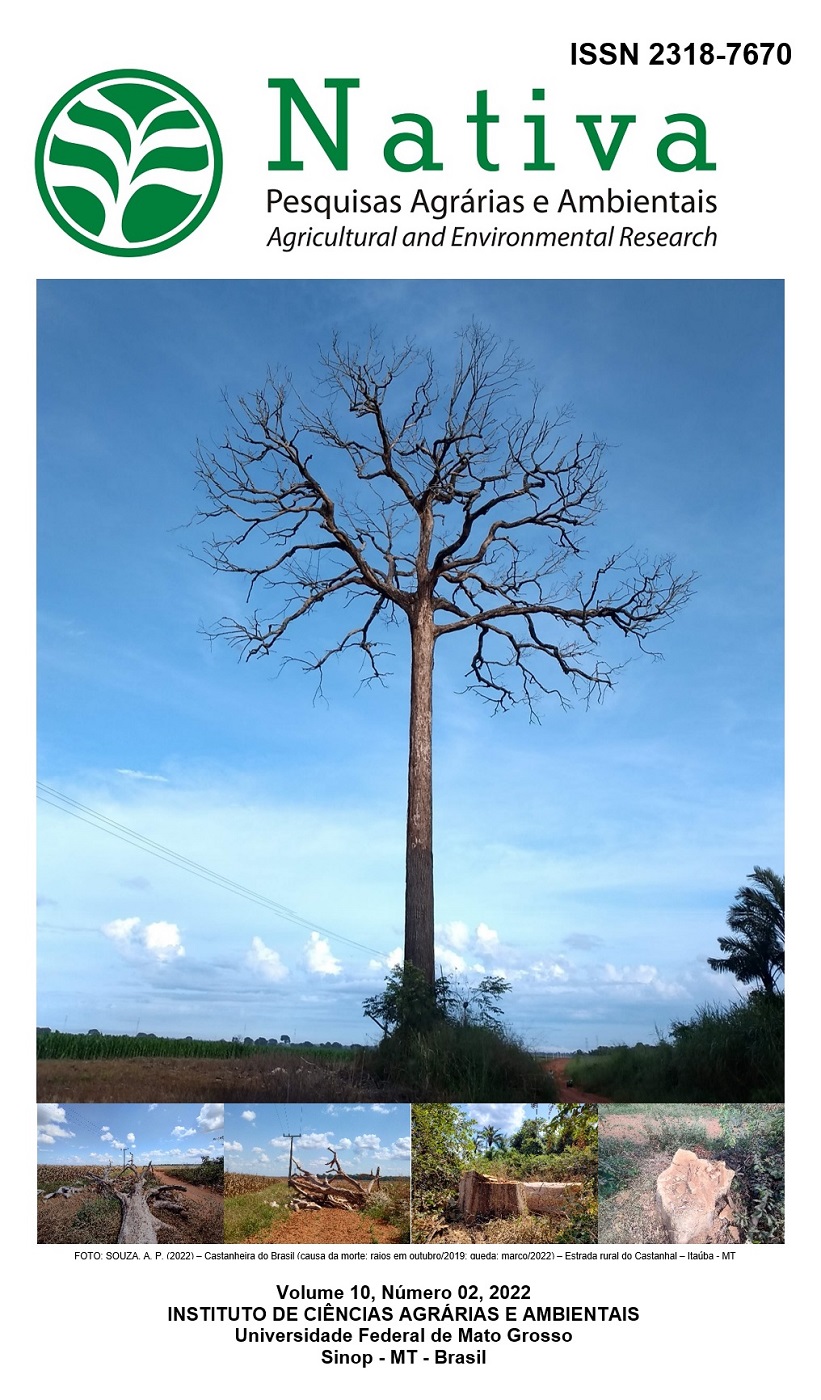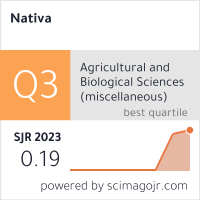EFFECT OF ACETYLATION ON TECHNOLOGICAL CHARACTERISTICS OF Jacaranda copaia WOOD: PART 1 – PHYSICAL AND MECHANICAL PROPERTIES
DOI:
https://doi.org/10.31413/nativa.v10i2.13665Palavras-chave:
modificação química, estabilidade dimensional, durezaResumo
ABSTRACT: The objective of this work was to evaluate the effect of acetylation on the technological characteristics of Jacaranda copaia (Aubl.) D. Don. wood. Physical (apparent and basic densities, water absorption, and thickness swelling) and mechanical (Rockwell hardness) properties were evaluated. Wood acetylation was carried out by immersion of samples in acetic anhydride; five treatments were evaluated: control (no acetylation), acetylation for 2 hours, acetylation for 4 hours, acetylation for 6 hours, and acetylation for 8 hours. All reactions were carried out at a constant temperature of 90 °C. The results show that the 8-hour acetylation treatment presented the highest weight gain (21.62%). This treatment also presented the lowest water absorption (119.55%) and the highest Rockwell hardness (24.78 HRL). In general, the acetylation treatment resulted in interesting improvements in wood’s physical and mechanical properties.
Keywords: chemical modification; dimensional stability; hardness.
Efeito da acetilação nas características tecnológicas da madeira de Jacaranda copaia: Parte 1 – propriedades físicas e mecânicas
RESUMO: O trabalho teve como objetivo avaliar a eficiência da acetilação para madeira de Jacaranda copaia (Aubl.) D. Don. em suas características tecnológicas. Para isso, foram avaliadas propriedades físicas (densidade aparente e básica, absorção em água e inchamento em espessura) e a mecânica (dureza Rockwell). A acetilação da madeira foi realizada mediante imersão de amostras em anidrido acético, sendo avaliados cinco tratamentos: controle (não acetiladas), acetilação por 2 h, acetilação por 4 h, acetilação por 6 h e acetilação por 8 h. Todas as reações realizadas com a temperatura constante de 90 °C. Os resultados mostram que o maior ganho de massa foi apresentado pelo tratamento de acetilação durante 8 horas, como o valor de 21,62%. O tratamento também apresentou o menor valor de absorção de água, sendo 119,55%, e o maior valor para dureza Rockwell, sendo 24,78 HRL. De modo geral, o tratamento de acetilação promoveu melhorias interessantes nas propriedades físicas e mecânicas da madeira.
Palavras-chave: modificação química; estabilidade dimensional; dureza.
Referências
AJDINAJ, D.; LATO, E.; QUKI, D.; COTA, H. Modification of some Albanian wood properties through chemical treatment. International Journal of Physical Sciences, v. 8, p. 356-361, 2013.
ASSOCIAÇÃO BRASILEIRA DE NORMAS TÉCNICAS (ABNT). NBR 7190: Projeto de estruturas de madeira. Rio de Janeiro: ABNT, 1997. 107p.
BECK, G.; THYBRING, E. E.; THYGESEN, L. G. Brown-rot fungal degradation and de-acetylation of acetylated wood. International Biodeterioration & Biodegradation, v. 135, p. 62–70, 2018. DOI: 10.1016/j.ibiod.2018.09.009.
BI, W.; LI, H.; HUI, D.; GAFF, M.; LORENZO, R.; CORBI, I.; CORBI, O.; ASHRAF, M. Effects of chemical modification and nanotechnology on wood properties. Nanotechnology Reviews, v.10, p. 978-1008, 2021. DOI: 10.1515/ntrev-2021-0065.
BONGERS, H. P. M.; BECKERS, E. P. J. Mechanical properties of acetylated solid wood treated on pilot plant scale. European conference on wood modification. Ghent, Belgium, p. 341–351, 2003.
BRUM, S. S.; OLIVEIRA, L. C. A.; BIANCHI, M. L.; GUERREIRO, M. C.; OLIVEIRA, L. K.; CARVALHO, K. T. G. Síntese de acetato de celulose a partir da palha de feijão utilizando n-bromossuccinimida (nbs) como catalisador. Polímeros, v. 22, n. 5, p. 447-452, 2012. DOI: 10.1590/S0104-14282012005000061.
CASTRO, V.; IWAKIRI, S. Influência de diferentes níveis de acetilação nas propriedades físico-mecânicas de aglomerados e painéis madeira-cimento. Cerne, v. 20. n. 4, p. 535-540, 2014.
CERMÁK, P.; BAAR, J.; DÖMÉNY, J.; VÝBOHOVÁ, E.; ROUSEK, R.; PAŘIL, P.; OBERLE, A.; ČABALOVÁ, I.; HESS, D.; VODÁK, M.; BRABEC, M. Wood-water interactions of thermally modified, acetylated and melamine formaldehyde resin impregnated beech wood. Holzforschung, v.76, n.5, p. 437-450, 2022. DOI: 10.1515/hf-2021-0164.
DIGAITIS, R.; THYBRING, E. E.; THYGESEN, L. G.; FREDRIKSSON, M. Targeted acetylation of wood: a tool for tuning wood-water interactions. Cellulose, v. 28, n. 12, p. 8009-8025, 2021. DOI: 10.1007/s10570-021-04033-z.
ELEOTÉRIO, J. R.; SILVA, C. M. K. Programas de secagem para Marupá (Simarouba amara), Pará-Pará (Jacaranda copaia) e Virola (Virola surinamensis). Floresta, v. 44, n. 2, p. 313-322, 2014.
ELRHAYAM, Y.; ELHARFI, A. 3D-QSAR studies of the chemical modification of hydroxyl groups of biomass (cellulose, hemicelluloses and lignin) using quantum chemical descriptors. Heliyon, v. 5, n. 8, 2019. DOI: 10.1016/j.heliyon.2019.e02173.
ESTEVES, B; NUNES L.; SAPORITI M. J. Utilização de madeira modificada na construção. CIMAD 11 – 1º Congresso Ibero-Latino Americano da Madeira na Construção, 7-9/06/2011, Coimbra, Portugal, 2011.
FARIAS-SINGER, R. Flora e Funga do Brasil. Jardim Botânico do Rio de Janeiro. Disponível em: <https://floradobrasil.jbrj.gov.br/FB114117>. Acesso em: 29 mai. 2022.
FIGUEIREDO, G. G.; BORTOLINI, A. T. P.; STANGERLIN, D. M.; PARIZ, E.; OLIVEIRA, D. S. Caracterização tecnológica da madeira de Trattinnickia burserifolia Mart. submetida ao tratamento de acetilação. Nativa, v. 7, n. 4, p. 420-425, 2019.
GOMES, D. F. F.; SILVA, J. R. M.; BIANCHI, M. L.; TRUGILHO, P. F. Avaliação da estabilidade dimensional da madeira acetilada de Eucalyptus grandis Hill ex. Maiden. Scientia Forestalis, n. 70, p. 125-130, 2006.
HUNT, C. G.; ZELINKA, S. L.; FRIHART, C. R.; LORENZ, L.; YELLE, D.; GLEBER, S. C.; VOGT, S.; JAKES, J. E. Acetylation increases relative humidity threshold for ion transport in wood cell walls–A means to understanding decay resistance. International Biodeterioration & Biodegradation, v. 133, p. 230-237, 2018.
LOPES, F. F. M.; ARAÚJO, G. T.; NASCIMENTO, J. W. N.; VASCONCELOS, R. F.; DANTAS, J. M. E. Avaliação dos efeitos da acetilação nas propriedades das fibras de caroá. Revista Brasileira de Engenharia Agrícola e Ambiental, v. 15, n. 1, p. 84-89, 2011.
MÄKELÄ, M.; ALTGEN, M.; BELT, T.; RAUTKARI, L. Hyperspectral imaging and chemometrics reveal wood acetylation on different spatial scales. Journal of Materials Science, v. 56, n. 8, p. 5053-5066, 2021. DOI: 10.1007/s10853-020-05597-0.
MARSICH, L.; COZZARINI, L.; FERLUGA, A.; SOLINAS, D.; SCHMID, C. The effect of acetylation on hybrid poplar after artificial weathering. International Wood Products Journal, v. 9, n. 3, p. 134-141, 2018. DOI: 10.1080/20426445.2018.1513893.
NÉMETH, R.; HORVÁTH, N.; FODOR, F.; BÁDER, M.; BAK, M. Wood Modification for under-utilised hardwood species. IOP Conference Series: Earth and Environmental Science. v. 551, n.1 2020. DOI: 10.1088/1755-1315/505/1/012017.
OLANIRAN, S. O.; MICHEN, B.; MENDEZ, D. F. M.; WITTEL, F. K.; BACHTIAR, E. V.; BURGERT, I.; RÜGGEBERG, M. Mechanical behaviour of chemically modified Norway spruce (Picea abies L. Karst.): Experimental mechanical studies on spruce wood after methacrylation and in situ polymerization of styrene. Wood Science and Technology, v. 53, n. 2, p. 425-445, 2019. DOI: 10.1007/s00226-019-01080-5.
QUINTANA, E.; MARIKO AGO, M.; VALLS, C.; RONCERO, M. B.; ROJAS, O. J. Alternative chemo-enzymatic treatment for homogeneous and heterogeneous acetylation of wood fibers. Cellulose, v. 25, n. 9, p. 5323-5336, 2018. DOI: 10.1007/s10570-018-1947-4.
ROWELL, R. M. Chemical modification: a non-toxic approach to wood preservation. In: 2nd International Conference on Environmentally-Compatible Forest Products, 2006, Oporto. Anais... Oporto: Fernando Pessoa University, 2006, p. 227-237.
SCHARF, A.; NEYSES, B.; SANDBERG, D. Hardness of surface-densified wood. Part 1: material or product property? Holzforschung, v. 76, n. 6, p. 503-514, 2022. DOI: 10.1515/hf-2021-0151.
STANGERLIN, D. M.; COSTA, A. F.; MONTEIRO, T. C.; GARLET, A. Dureza Rockwell da madeira de três espécies amazônicas submetidas a ensaios de apodrecimento acelerado. Ciência Rural, v. 43, n. 4, p. 623-630, 2013.
SYDOR, M.; PINKOWSKI, G.; KUCERKA, M.; KMINIAK, R.; ANTOV, P.; ROGOZINSKI, T. Indentation hardness and elastic recovery of some hardwood species. Applied Sciences, v. 12, n. 10, p. 5049, 2022. DOI: 10.3390/app12105049.
TEACĂ, C. A.; TANASA, F. Wood surface modification-classic and modern approaches in wood chemical treatment by esterification reactions. Coatings, v. 10, n. 7, p. 629, 2020. DOI: 10.3390/coatings10070629.
VAN DER LUGT, P.; BONGERS, F. VOGTLANDER, J. Environmental impact of constructions made of acetylated wood. In: Proceedings of the World Conference on Timber Engineering (WCTE 2016). 2016. p. 22-25.
WOJEICCHOWSKI, J. P.; SOQUEORA, G. L. A.; LACERDA, L. G.; SCHNOTZLER, E.; DEMIATE, I. M. Physicochemical, structural and thermal properties of oxidized, acetylated and dual-modified common bean (Phaseolus vulgaris L.) starch. Food Science and Technology, v. 38, n. 2, p. 318-327, 2018. DOI: 10.1590/1678-457x.04117.
XIE, Y.; FU, Q.; WANG, Q.; XIAO, Z.; MILITZ, H. Effects of chemical modification on the mechanical properties of wood. European Journal of Wood and Wood Products, v. 71, n. 4, p. 401-416, 2013. DOI: 10.1007/s00107-013-0693-4.
Downloads
Publicado
Versões
- 2024-06-11 (2)
- 2022-06-22 (1)
Edição
Seção
Como Citar
Licença
Copyright (c) 2022 Nativa

Este trabalho está licenciado sob uma licença Creative Commons Attribution-NonCommercial 4.0 International License.
Direitos Autorais para artigos publicados nesta revista são do autor, com direitos de primeira publicação para a revista. Em virtude de a aparecerem nesta revista de acesso público, os artigos são de uso gratuito, com atribuições próprias, em aplicações educacionais e não-comerciais.
A artigos publicados nessa revista, podem ser reproduzidos parcialmente ou utilizados como referência por outros autores, desde que seja cita a fonte, ou seja, a Revista Nativa.
Copyright for articles published in this journal are the authors, with first publication rights granted to the journal. The journal shows open access, and articles are free to use, with proper attribution, in educational and non-commercial.
The articles published in this journal may be reproduced in part or used as a reference by other authors, provided that the source is quoted.






